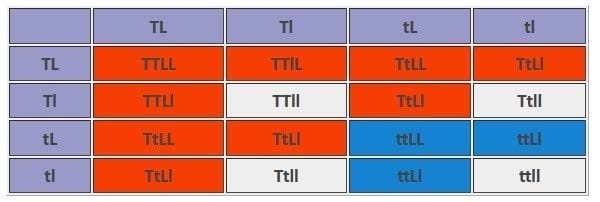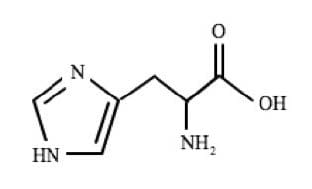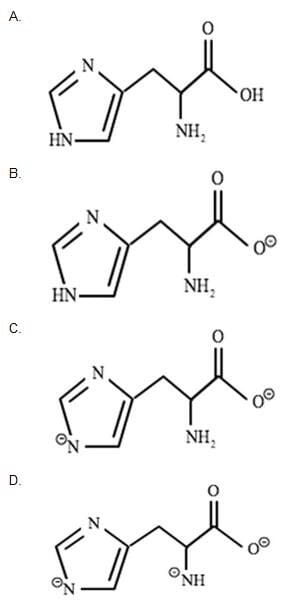Exam Details
Exam Code
:MCAT-TESTExam Name
:Medical College Admission Test: Verbal Reasoning, Biological Sciences, Physical Sciences, Writing SampleCertification
:Medical Tests CertificationsVendor
:Medical TestsTotal Questions
:812 Q&AsLast Updated
:Apr 16, 2025
Medical Tests Medical Tests Certifications MCAT-TEST Questions & Answers
-
Question 411:
An individual is born with a mutation causing her to partially retain a form of fetal hemoglobin into adulthood. Compared to a normal individual, this person would exhibit:
A. no differences from a normal adult.
B. significantly reduced oxygen binding in the lungs.
C. no symptoms, since retention of fetal hemoglobin would be fatal.
D. increased oxygen binding to hemoglobin in the tissues.
-
Question 412:

For a particular plant, straight leaves result from a dominant gene (L) and wrinkled leaves result from a recessive gene (l), and tall height results from a dominant gene (T) while short height results from a recessive gene (t). A dihybrid cross is performed with plants heterozygous for both traits. What is the expected ratio of short, straight-leaved plants to tall, straight-leaved plants?
A. 1:1
B. 1:2
C. 1:3
D. 3:1
-
Question 413:
The lining of the digestive tract and the respiratory tract develops from which germ layer?
I. Endoderm
II. Mesoderm
III.
Ectoderm
A.
I only
B.
II only
C.
III only
D.
I and II
-
Question 414:
Which of the following are steroid-based molecules?
I. Testosterone
II. Triglycerides
III. Progesterone
IV.
DNA
A.
I only
B.
I, II, and III
C.
I and III
D.
I, III, and IV
-
Question 415:

The amino acid histidine has a nitrogen-containing side chain. The pKa for the carboxylic acid group, imidazole side chain, and the primary amine has a value of 1.8, 6.0, and 9.0, respectively. Which of the following structures accurately reflects the predominate form of histidine at a normal physiological pH of 7.4?

A. Option A
B. Option B
C. Option C
D. Option D
-
Question 416:
Diisopropylfluorophosphate (DFP) binds to the active site of acetylcholinesterase (ACE) in the synapses of neurons. When DFP binds to ACE, the ACE enzyme is rendered permanently inactive. This makes DFP a potent toxin, with lethal amounts at less than 100 mg. The interaction between DFP and ACE can best be characterized as:
A. Competitive inhibition
B. Noncompetitive inhibition
C. Irreversible inhibition
D. Partially competitive inhibition
-
Question 417:
A certain molecule acts by cytochrome oxidase A3, the final enzyme in the electron transport chain. Administration of a large dose of this substance to a human would likely:
A. lead to death due to an inability of the cell to pass electrons to oxygen, thus stopping aerobic respiration and asphyxiating the cells.
B. lead to death due to an inadequate supply of ADP to accept a phosphate group at the ATP synthase enzyme.
C. have no effect as cells would switch which macronutrient they metabolize to circumvent the blocked biochemical pathway.
D. increase the cell's ATP production as negative feedback would cause the cell to up-regulate anaerobic pathways.
-
Question 418:
Myoclonic epilepsy and ragged-red fiber (MERRF) is an extremely rare disorder that affects neuromuscular systems. MERRF results from a mutation in mitochondrial DNA (mtDNA) that impairs protein synthesis, oxygen consumption, and energy production. When an affected male and a normal female reproduce, which of the following best predicts the expected phenotypic ratios of the offspring?
A. None of the offspring will be affected.
B. All males and no females will be affected.
C. Half of males and half of females will be affected.
D. One-fourth of the offspring will be affected.
-
Question 419:
A person suffering from severe dehydration and starvation would NOT be expected to have elevated plasma concentrations for which of the following hormones?
A. Antidiuretic hormone (ADH)
B. Cortisol
C. Aldosterone
D. Insulin
-
Question 420:
In nerve cells, microtubule-associated proteins (MAPs), most notably MAP2 and MAP tau, act to stabilize microtubules. In a mouse model, a mutant is developed that vastly reduced function across all families of MAPs, leading to increased microtubule degradation. Which cellular activity would likely be most affected?
A. Cardiac muscle contraction
B. Transcription of mRNA from DNA
C. Krebs cycle
D. Meiosis
Related Exams:
Tips on How to Prepare for the Exams
Nowadays, the certification exams become more and more important and required by more and more enterprises when applying for a job. But how to prepare for the exam effectively? How to prepare for the exam in a short time with less efforts? How to get a ideal result and how to find the most reliable resources? Here on Vcedump.com, you will find all the answers. Vcedump.com provide not only Medical Tests exam questions, answers and explanations but also complete assistance on your exam preparation and certification application. If you are confused on your MCAT-TEST exam preparations and Medical Tests certification application, do not hesitate to visit our Vcedump.com to find your solutions here.